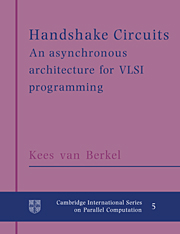Book contents
- Frontmatter
- Contents
- Foreword
- Preface
- 0 Introduction
- 1 Introduction to Tangram and handshake circuits
- 2 Examples of VLSI programs
- 3 Handshake processes
- 4 Handshake circuits
- 5 Sequential handshake processes
- 6 Tangram
- 7 Tangram → handshake circuits
- 8 Handshake circuits → VLSI circuits
- 9 In practice
- A Delay insensitivity
- B Failure semantics
- Bibliography
- Glossary of symbols
- Index
A - Delay insensitivity
Published online by Cambridge University Press: 14 January 2010
- Frontmatter
- Contents
- Foreword
- Preface
- 0 Introduction
- 1 Introduction to Tangram and handshake circuits
- 2 Examples of VLSI programs
- 3 Handshake processes
- 4 Handshake circuits
- 5 Sequential handshake processes
- 6 Tangram
- 7 Tangram → handshake circuits
- 8 Handshake circuits → VLSI circuits
- 9 In practice
- A Delay insensitivity
- B Failure semantics
- Bibliography
- Glossary of symbols
- Index
Summary
Introduction
In [Udd84, Udd86, Ebe89, UV88] the notions delay insensitivity, independent alphabet and absence of computation interference have been defined for directed processes. In this section we investigate to what extent these notions apply to handshake processes.
Definition A.O (directed process)
A directed process T is a triple (iT,oT,tT), in which iT and oT are disjoint sets of symbols and tT is a non-empty, prefix-closed subset of (iT ∪ oT).
A handshake process is not a directed process: the alphabet of a handshake process has more structure and the trace set is not prefix closed. However, to every handshake process P there corresponds a directed process, viz. (iP,oP,tP≤) .
All port structures in this appendix have no internal ports.
Composability
Composability of traces captures the notion that symbols communicated between processes arrive no earlier than they were sent. Consider directed processes P and Q such that iP = oQ and oP = iQ. Let s ∈ tP and t ∈ tQ. Composability restricts the way the pair (s,t) may evolve from (ε,ε). Let a ∈ iQ (and therefore a ∈ oP). Then ε is composable to a, but the converse is not true, because a must be sent by P before it can be received by Q. Similarly, for b ∈ oQ, we have b composable to ε. Also, trace s is composable to ta if s is composable to t and a is on its way, i.e. len.(t⌈a) < len.(s⌈a).
- Type
- Chapter
- Information
- Handshake CircuitsAn Asynchronous Architecture for VLSI Programming, pp. 195 - 200Publisher: Cambridge University PressPrint publication year: 1994



